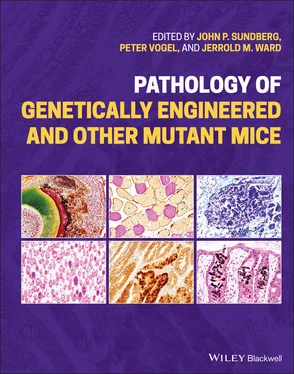Pathology of Genetically Engineered and Other Mutant Mice
Здесь есть возможность читать онлайн «Pathology of Genetically Engineered and Other Mutant Mice» — ознакомительный отрывок электронной книги совершенно бесплатно, а после прочтения отрывка купить полную версию. В некоторых случаях можно слушать аудио, скачать через торрент в формате fb2 и присутствует краткое содержание. Жанр: unrecognised, на английском языке. Описание произведения, (предисловие) а так же отзывы посетителей доступны на портале библиотеки ЛибКат.
- Название:Pathology of Genetically Engineered and Other Mutant Mice
- Автор:
- Жанр:
- Год:неизвестен
- ISBN:нет данных
- Рейтинг книги:3 / 5. Голосов: 1
-
Избранное:Добавить в избранное
- Отзывы:
-
Ваша оценка:
- 60
- 1
- 2
- 3
- 4
- 5
Pathology of Genetically Engineered and Other Mutant Mice: краткое содержание, описание и аннотация
Предлагаем к чтению аннотацию, описание, краткое содержание или предисловие (зависит от того, что написал сам автор книги «Pathology of Genetically Engineered and Other Mutant Mice»). Если вы не нашли необходимую информацию о книге — напишите в комментариях, мы постараемся отыскать её.
An updated and comprehensive reference to pathology in every organ system in genetically modified mice Pathology of Genetically Engineered and Other Mutant Mice
Pathology of Genetically Engineered and Other Mutant Mice
Pathology of Genetically Engineered and Other Mutant Mice — читать онлайн ознакомительный отрывок
Ниже представлен текст книги, разбитый по страницам. Система сохранения места последней прочитанной страницы, позволяет с удобством читать онлайн бесплатно книгу «Pathology of Genetically Engineered and Other Mutant Mice», без необходимости каждый раз заново искать на чём Вы остановились. Поставьте закладку, и сможете в любой момент перейти на страницу, на которой закончили чтение.
Интервал:
Закладка:
60 60 Gondo, Y. (2008). Trends in large‐scale mouse mutagenesis: from genetics to functional genomics. Nat. Rev. Genet. 9 (10): 803–810.
61 61 Chang, H., Pan, Y., Landrette, S. et al. (2019). Efficient genome‐wide first‐generation phenotypic screening system in mice using the piggyBac transposon. Proc. Natl. Acad. Sci. U.S.A. 116 (37): 18507–18516.
62 62 Birling, M.C., Herault, Y., and Pavlovic, G. (2017). Modeling human disease in rodents by CRISPR/Cas9 genome editing. Mamm. Genome 28 (7‐8): 291–301.
63 63 Brehm, M.A., Wiles, M.V., Greiner, D.L., and Shultz, L.D. (2014). Generation of improved humanized mouse models for human infectious diseases. J. Immunol. Methods 410: 3–17.
64 64 Hosur, V., Low, B.E., Avery, C. et al. (2017). Development of humanized mice in the age of genome editing. J. Cell. Biochem. 118 (10): 3043–3048.
65 65 Low, B.E., Krebs, M.P., Joung, J.K. et al. (2014). Correction of the Crb1rd8 allele and retinal phenotype in C57BL/6N mice via TALEN‐mediated homology‐directed repair. Invest. Ophthalmol. Vis. Sci. 55 (1): 387–395.
66 66 Brommage, R., Powell, D.R., and Vogel, P. (2019). Predicting human disease mutations and identifying drug targets from mouse gene knockout phenotyping campaigns. Dis. Models Mech. 12 (5).
67 67 Bradley, A., Anastassiadis, K., Ayadi, A. et al. (2012). The mammalian gene function resource: the International Knockout Mouse Consortium. Mamm. Genome 23 (9‐10): 580–586.
68 68 Meehan, T.F., Conte, N., West, D.B. et al. (2017). Disease model discovery from 3,328 gene knockouts by The International Mouse Phenotyping Consortium. Nat. Genet. 49 (8): 1231–1238.
69 69 Kaloff, C., Anastassiadis, K., Ayadi, A. et al. (2016). Genome wide conditional mouse knockout resources. Drug Discovery Today 20: 3–12.
70 70 Dickinson, M.E., Flenniken, A.M., Ji, X. et al. (2016). High‐throughput discovery of novel developmental phenotypes. Nature 537 (7621): 508–514.
71 71 Moore, B.A., Leonard, B.C., Sebbag, L. et al. (2018). Identification of genes required for eye development by high‐throughput screening of mouse knockouts. Commun. Biol. 1: 236.
72 72 Rozman, J., Rathkolb, B., Oestereicher, M.A. et al. (2018). Identification of genetic elements in metabolism by high‐throughput mouse phenotyping. Nat. Commun. 9 (1): 288.
73 73 Sundberg, J.P., Dadras, S.S., Silva, K.A. et al. (2017). Systematic screening for skin, hair, and nail abnormalities in a large‐scale knockout mouse program. PLoS One 12 (7): e0180682.
74 74 Smedley, D., Oellrich, A., Köhler, S. et al. (2013). PhenoDigm: analyzing curated annotations to associate animal models with human diseases. Database 2013: bat025. https://doi.org/10.1093/database/bat025.
75 75 Hoehndorf, R., Schofield, P.N., and Gkoutos, G.V. (2013). An integrative, translational approach to understanding rare and orphan genetically based diseases. Interface Focus 3 (2): 20120055.
76 76 Hoehndorf, R., Schofield, P.N., and Gkoutos, G.V. (2011). PhenomeNET: a whole‐phenome approach to disease gene discovery. Nucleic Acids Res. 39 (18): e119.
77 77 Klement, J.F., Matsuzaki, Y., Jiang, Q.J. et al. (2005). Targeted ablation of the Abcc6 gene results in ectopic mineralization of connective tissues. Mol. Cell. Biol. 25 (18): 8299–8310.
78 78 Gorgels, T.G., Hu, X., Scheffer, G.L. et al. (2005). Disruption of Abcc6 in the mouse: novel insight in the pathogenesis of pseudoxanthoma elasticum. Hum. Mol. Genet. 14 (13): 1763–1773.
79 79 Berndt, A., Li, Q., Potter, C.S. et al. (2013). A single‐nucleotide polymorphism in the Abcc6 gene associates with connective tissue mineralization in mice similar to targeted models for pseudoxanthoma elasticum. J. Invest. Dermatol. 133 (3): 833–836.
80 80 Hawkes, J.E., Adalsteinsson, J.A., Gudjonsson, J.E., and Ward, N.L. (2018). Research techniques made simple: murine models of human psoriasis. J. Invest. Dermatol. 138 (1): e1–e8.
81 81 Jordan, C.T., Cao, L., Roberson, E.D. et al. (2012). Rare and common variants in CARD14, encoding an epidermal regulator of NF‐kappaB, in psoriasis. Am. J. Hum. Genet. 90 (5): 796–808.
82 82 Jordan, C.T., Cao, L., Roberson, E.D. et al. (2012). PSORS2 is due to mutations in CARD14. Am. J. Hum. Genet. 90 (5): 784–795.
83 83 Mellett, M., Meier, B., Mohanan, D. et al. (2018). CARD14 gain‐of‐function mutation alone is sufficient to drive IL‐23/IL‐17‐mediated psoriasiform skin inflammation in vivo. J. Invest. Dermatol. 138 (9): 2010–2023.
84 84 Wang, M., Zhang, S., Zheng, G. et al. (2018). Gain‐of‐function mutation of Card14 leads to spontaneous psoriasis‐like skin inflammation through enhanced keratinocyte response to IL‐17A. Immunity 49 (1): 66–79. e5.
85 85 Sundberg, J.P., Pratt, C.H., Silva, K.A. et al. (2019). Gain of function p.E138A alteration in Card14 leads to psoriasiform skin inflammation and implicates genetic modifiers in disease severity. Exp. Mol. Pathol. 110: 104286.
86 86 Threadgill, D.W. and Churchill, G.A. (2012). Ten years of the collaborative cross. G3 2 (2): 153–156.
87 87 Svenson, K.L., Gatti, D.M., Valdar, W. et al. (2012). High‐resolution genetic mapping using the Mouse Diversity outbred population. Genetics 190 (2): 437–447.
88 88 Schofield, P.N., Hoehndorf, R., and Gkoutos, G.V. (2012). Mouse genetic and phenotypic resources for human genetics. Hum. Mutat. 33 (5): 826–836.
89 89 Lehner, B. (2013). Genotype to phenotype: lessons from model organisms for human genetics. Nat. Rev. Genet. 14 (3): 168–178.
90 90 Cox, R.D. and Church, C.D. (2011). Mouse models and the interpretation of human GWAS in type 2 diabetes and obesity. Dis. Models Mech. 4 (2): 155–164.
91 91 Shultz, L.D., Keck, J., Burzenski, L. et al. (2019). Humanized mouse models of immunological diseases and precision medicine. Mamm. Genome 30 (5‐6): 123–142.
92 92 Bernards, R., Jaffee, E., Joyce, J.A. et al. (2020). A roadmap for the next decade in cancer research. Nat. Cancer. 1: 12–17.
5 Embryos, Placentas, and Neonates
Brad Bolon and Jerrold M. Ward
Introduction
Comparative pathologists who evaluate adult mice can phenotype developing mice as well. However, new practitioners will need to attain familiarity with unusual anatomic features, physiological processes, and lesion patterns that are the norm in embryos and neonates. Most investigators approach histopathological evaluation of late‐stage embryos (gestational day [GD] 15.5 or older), neonates, and juveniles (up to postnatal day [PND] 42) with confidence due to anatomic similarities between these developmental stages and adult mice. This assurance fades when the rapidly evolving morphology of earlier embryos and their extra‐embryonic membranes needs to be characterized.
This chapter offers a brief introduction to key anatomical and pathophysiological concepts in prenatal and early postnatal mice. More detailed coverage of specific mouse developmental anatomy and pathology topics is available in other books [1–5], book chapters [6–9], anatomic atlases [10–15], major review articles [16–27], and websites [15,28–30].
Four‐Dimensional Anatomy of the Developing Mouse
Stages of mouse development are defined in terms of major events in four dimensions: length, width, breadth, and time ( Figure 5.1). Specific stages typically are assigned using the Theiler staging (TS) system based on visible anatomic landmarks [11, 15, 29, 31, 32]. Timing for each event varies by up to 12 hours among strains with different genetic backgrounds [33, 34]. Furthermore, the developmental stages in any litter differ by between 10 to 24 hours for the oldest and youngest embryos ( Figure 5.2) [2, 11, 33]. Accordingly, developmental stage is not equal to developmental age for prenatal mice. In utero age is assigned as either “days post coitum ” (dpc) or as “gestational day” (GD, often referred to as “embryonic day” [E]). When using the GD (or E) timing convention, it is imperative that investigators note whether the day of conception is counted as GD0 or GD1 since this choice will dramatically impact the times assigned to developmental landmarks. The convention used in this chapteris that the presence of a vaginal plug is designated as 0 dpc (or GD0).
Читать дальшеИнтервал:
Закладка:
Похожие книги на «Pathology of Genetically Engineered and Other Mutant Mice»
Представляем Вашему вниманию похожие книги на «Pathology of Genetically Engineered and Other Mutant Mice» списком для выбора. Мы отобрали схожую по названию и смыслу литературу в надежде предоставить читателям больше вариантов отыскать новые, интересные, ещё непрочитанные произведения.
Обсуждение, отзывы о книге «Pathology of Genetically Engineered and Other Mutant Mice» и просто собственные мнения читателей. Оставьте ваши комментарии, напишите, что Вы думаете о произведении, его смысле или главных героях. Укажите что конкретно понравилось, а что нет, и почему Вы так считаете.












